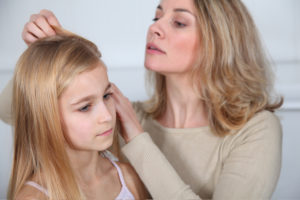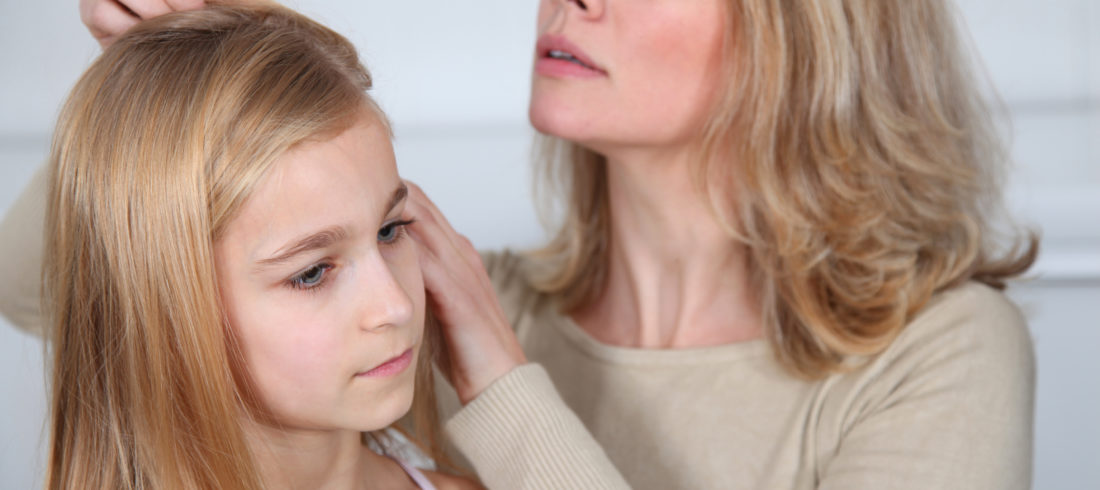There are approximately 12 million cases of head lice infestation in the United States every year. There is no “season” for head lice, however it tends to peak as kids return to school in the fall and then again in January after the winter school break. Head lice favor all socioeconomic groups and make themselves at home regardless of the health, hygiene, or cleanliness of their unwilling hosts. Children 3-11 years old have the highest incidence. It is more common in girls because of their tendency to have longer hair and the common exchange of hair brushes and accessories.
What are Lice?
Lice are blood-sucking wingless insects that are the size of sesame seeds. They feed exclusively on the blood of humans for 4-6 hours and lay between 4-5 eggs a day. The eggs are called “nits” and they are laid close to the scalp for the warmth. But, in warm weather, nits can also be found far from the scalp. Transmission is via head-to-head contact or using brushes, blow-dryers, hair accessories, bedding, hats, helmets…etc.
The classic symptom is intense itching of the scalp which can vary among patients. In the first infestation, it might take 2-4 weeks before the patient notices the itching. The itching reflects an immunologic response to lice saliva and excretions. However, a number of individuals are asymptomatic and are considered “carriers”.
Always check if your child has lice by sitting him/ her under a bright light and separating hair into sections. Search each section for eggs (nits) that look like tiny seeds attached to the hair. One quick way to recognize nits is that, in contrast to dandruff, the nits cannot be easily removed from the hair. The eggs (nits) have a grey or caramel color when laid, and they turn yellow to white when they are empty. Adult lice and nymphs (baby lice) are grayish white or tan in color.
Lice and nits are more commonly found in the hair behind the ears and around the nape of the neck.
How Can You Prevent Head Lice Infestation?
Teach your child to stop sharing things that touch the head. Brushes, combs, hair accessories, hats, helmets, scarves, towels, and even earbuds offer head lice a good place to hang out until they can crawl onto a human.
What Should you do if the School Reports Lice Infestation?
- Check your child’s hair.
- Inspect household items that can get infested with lice and nits such as towels, rugs, and bedding.
- Look carefully at the clothes your child has worn during the past 2 days for lice and their eggs
- Tell your child to stop head-to-head contact with other kids and reinforce the message to stop sharing anything that touches the head.
What Should You do if You Find Lice/Nits:
- Pyrethrin (e.g.Rid, Triple X, Pronto) and Permethrin (e.g. Nix) are the two FDA approved over-the-counter treatments. Start with one of those. And only use one. Remember, regardless of the package instructions two applications 1 week apart are advisable in order to kill the nits that survived the treatment, defend against the growing resistance to treatment and to reduce the risk of re-infestation.
- The treatment usually involves lathering the shampoo into the hair and leaving it on for a ten minutes before rinsing it out. Comb through the wet hair with the lice comb that comes with the
 shampoo. The teeth on these combs are much closer together than regular combs and more likely to remove the lice and nits.
shampoo. The teeth on these combs are much closer together than regular combs and more likely to remove the lice and nits. - The products should be applied to a fully dressed person, and rinse the product out with a spray hose or running water from a sink. These products are not meant for use while taking a shower or bath. You will want to limit the amount of skin that the product touches.
- Look at the hair 8 to 12 hours after treatment. If the lice seem as active as they were before the treatment, the medicine may not be working. Do not treat again. Talk with your dermatologist. A different lice medicine may be necessary.
- If the treatment is working, avoid shampooing the hair again for at least 2 days. This lets the medication continue to work. Repeat the whole process in about 1 week.
- Continue to comb through the hair once a day for at least 3 weeks to be sure you remove the lice and their nits. This is often easier to do with wet hair.
- Use hot water +130°F to wash clothes, sheets, pillowcases, blankets, and anything the person’s head may have touched. Seal non-washable items such as stuffed animals in a plastic bag for several weeks.
- Soak combs and brushes in hot water 130°F for at least 10 minutes.
- Vacuum carpets and furniture. Do not use lice-killing sprays because chemicals can cause more harm than the lice.
Should You Treat Other Family Members and Friends?
It is very common for close family and friends to get head lice. You do not want to treat anyone who does not have head lice; however, you should check everyone every day for 10 to 15 days.
Claims and Myths:
There are unsubstantiated claims of successful treatment with alternative non-pesticidal products including petroleum jelly, hair pomade, olive oil, mayonnaise, vegetable oil and mineral oil. Such products may slow the movement of the adult lice and allow them to be easily combed out of the scalp but these substances do not kill the lice.
Some essential oils have been reported to be effective as lice therapy and are incorporated in different products but more clinical studies are needed to confirm the safety and efficacy of these products.
Most studies have shown that mechanical removal alone (i.e. wet combing) is not as effective as mechanical removal combined with a pediculicide (lice treatment). Proper treatment with medication is advised.
End the Epidemic
We as parents, teachers and health care providers are responsible to help end the epidemic of head lice by educating our children on how to prevent the infestation and by treating our children properly with FDA approved treatments that are proven to be effective and safe.

